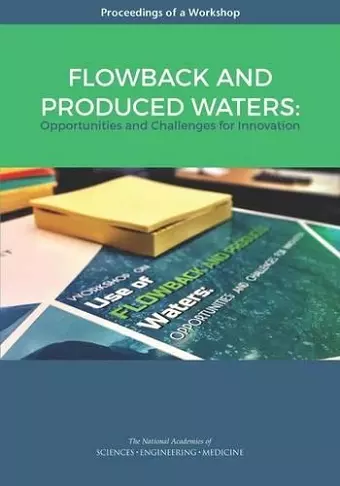Flowback and Produced Waters
Opportunities and Challenges for Innovation: Proceedings of a Workshop
Division on Earth and Life Studies author Board on Earth Sciences and Resources author Water Science and Technology Board author National Academies of Sciences, Engineering, and Medicine author Roundtable on Unconventional Hydrocarbon Development author Ed J Dunne editor
Format:Paperback
Publisher:National Academies Press
Published:27th Mar '17
Currently unavailable, and unfortunately no date known when it will be back

Produced water—water from underground formations that is brought to the surface during oil and gas production—is the greatest volume byproduct associated with oil and gas production. It is managed by some combination of underground injection, treatment and subsequent use, treatment and discharge, or evaporation, subject to compliance with state and federal regulations. Management of these waters is challenging not only for industry and regulators, but also for landowners and the public because of differences in the quality and quantity of produced water, varying infrastructure needs, costs, and environmental considerations associated with produced water disposal, storage, and transport.
Unconventional oil and gas development involves technologies that combine horizontal drilling with the practice of hydraulic fracturing. Hydraulic fracturing is a controlled, high-pressure injection of fluid and proppant into a well to generate fractures in the rock formation containing the oil or gas. After the hydraulic fracture procedure is completed, the injected fluid is allowed to flow back into the well, leaving the proppant in the newly created fractures. As a result, a portion of the injected water returns to the surface and this water is called "flowback water" which initially may mix with the naturally occurring produced water from the formation. The chemistry and volume of water returning to the surface from unconventional oil and gas operations thus changes during the lifetime of the well due to the amount of fluid used in the initial stage of well development, the amount of water naturally occurring in the geologic formation, the original water and rock chemistry, the type of hydrocarbon being produced, and the way in which production is conducted. The volume and composition of flowback and produced waters vary with geography, time, and site-specific factors.
A workshop was conducted by the National Academies of Sciences, Engineering, and Medicine to highlight the challenges and opportunities associated in managing produced water from unconventional hydrocarbon development, and particularly in the area of potential beneficial uses for these waters. This publication summarizes the presentations and discussions from the workshop.
Table of Contents- Front Matter
- 1 Introduction
- 2 Setting the Stage: Keynote Session
- 3 Regional Similarities and Differences: Environmental and Regulatory Context for Potential Use of Flowback and Produced Water
- 4 Technologies for Managing Flowback and Produced Waters for Potential Use
- 5 Characterization of Flowback and Produced Waters...
ISBN: 9780309452625
Dimensions: unknown
Weight: unknown
100 pages